Varieties of irrigation systems and their device
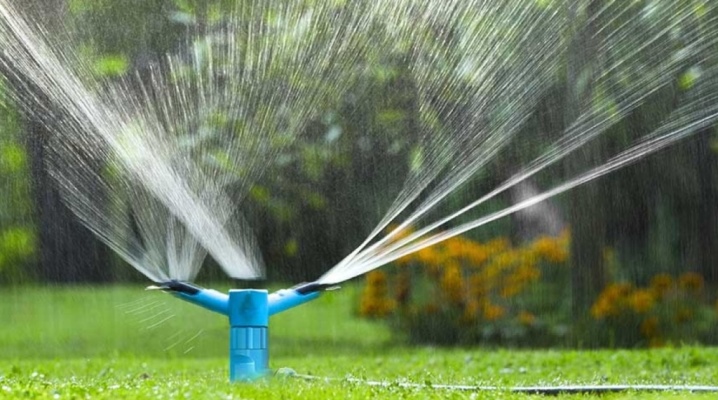
Irrigation systems - manual and automatic, drip and rainfall - are gaining in popularity. Installation, operation and conservation of irrigation equipment for the winter on the site does not require significant efforts. At the same time, irrigation systems for the vegetable garden and garden, for the lawn and the sports field make it possible to significantly facilitate manual labor, and reduce the time spent on caring for plants.
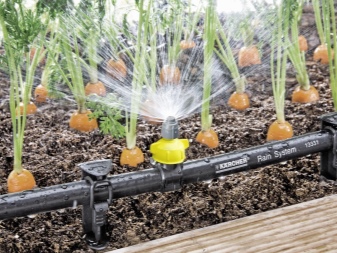
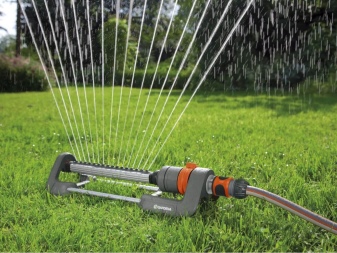
What it is?
Among agrotechnical measures, the process of plant saturation with moisture occupies a special place. Correctly organizing this process, reducing the cost of manual labor, is quite possible on a site of any area. An irrigation system is a type of engineering and technical structures used to supply water to individual parts of a vegetable garden, garden, lawn or sports field. It can be landscape or agricultural, laid on the surface or with the help of underground utilities.
In fact, this is nothing more than a miniature water supply system, however, using storage-type containers as a source of moisture.
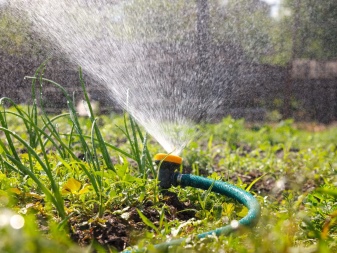
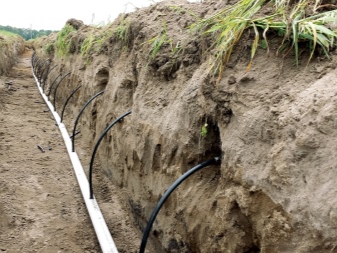
Irrigation systems include the following components:
- pipeline lines;
- pump equipment;
- hydraulic solenoid valves or mechanical shut-off valves;
- filtration elements;
- droppers, nozzles (for some systems);
- sensors and other types of automation;
- clamping fittings;
- water storage tanks.
Additional components are used in agricultural networks. These systems are equipped with pumping stations, gravel filters and fertilizer metering injectors. The water supply lines consist of pipes that can withstand a significant water pressure.
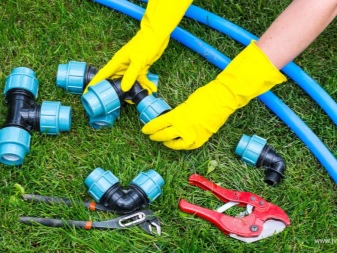

Views
All irrigation systems fall into 3 main categories. Depending on the control method, irrigation equipment can be automatic, manual or combined, combining mechanical and electronic components in its design.
The choice of equipment is based on the length of land holdings, the location of the beds, the frequency of visits to the site.
Automatic
An irrigation system of this type is connected to a pressure source of water or a reservoir. It can supply moisture to plants by drip or using spray nozzles, suitable for surface and recessed mounting.
There are three main differences from other irrigation systems.
- Programmable turn-on schedule. You can set not only the intensity of the pressure, but also the frequency of water supply.
- Use of submersible or surface type pumps. They are selected based on the type of container.
- Using additional sensors. You can set the parameters for switching on at a certain level of dryness of the soil, fix other changes. Some systems can be monitored remotely.
The use of automation elements allows you to provide irrigation equipment with higher efficiency. They exclude irregular water consumption, help to ensure its optimal supply according to a given schedule along several lines at once. Such equipment is suitable not only for caring for beds or greenhouses, flower beds at their summer cottage. It has perfectly proven itself as a component for a sports ground, garden and park landscapes, public areas.
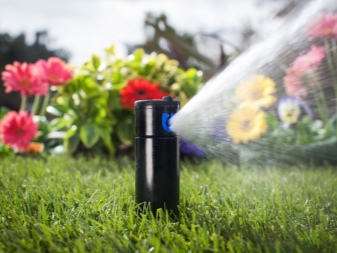

Manual
This type of irrigation system can hardly be called effective, but it still remains popular among fans of summer cottages. It is relevant for operation in small areas. It can be used to supply moisture to compact greenhouses, several nearby beds, flower beds. Such an irrigation system involves the use of a hose connected to a water supply system, the liquid is supplied with constant pressure from a tap or container.
The advantages of such a solution include only its simplicity and affordability. There are much more disadvantages:
- uneven moisture intake;
- the formation of a drying crust on the soil;
- stagnant water on the surface;
- high risk of plant burns.
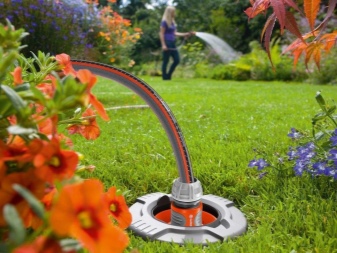
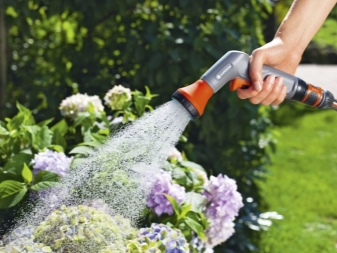
Combined
This type of irrigation system provides for manual control of the water supply. The valve or other shut-off valve opens, moisture is supplied to the pipeline. Such systems have the ability to adjust the pressure. The pipeline always has a small cross-section, is buried in the ground, and is connected to the crane with flexible adapters.
Sprinklers of the following types are connected to such systems:
- pulse;
- sector;
- pendulum;
- circular.
Semi-automatic irrigation systems can also be manufactured in the form of an irrigator with a drip method of moisture distribution. They are supplied with flexible tubes, in which holes are made with valves, under pressure of water passing the liquid out.
This version of the equipment combines the simplicity of manual irrigation and the possibility of dosing the supplied moisture.
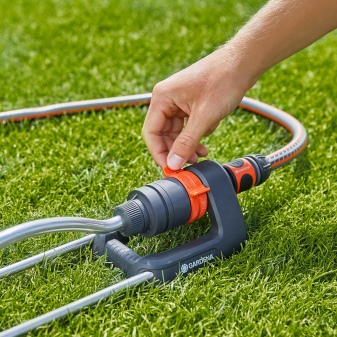
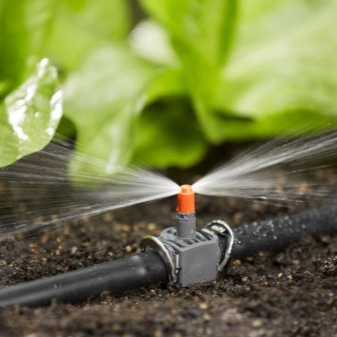
Types
By the type of their design, all irrigation systems are divided into several groups. Systems for the greenhouse and for the garden, for the beds in the country house differ in the device and method of moisture distribution. Professional engineering structures for agriculture involve underground laying of communications. For a summer cottage, a simpler version of irrigation equipment is suitable - a surface one.
It provides for the supply of water to the soil from a hose. Holes can be drilled in it to distribute moisture more evenly. But in general, such systems are not very effective, significantly increase the risks of stopping the supply of moisture to the roots. The best option in this case is to combine surface irrigation with other irrigation equipment. The following systems are considered the most popular.

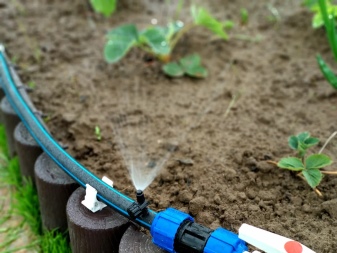
Subsoil
Such irrigation systems involve laying irrigation equipment under the main soil layer with a depth of about 30 cm. The pipeline is equipped with small holes that evenly distribute moisture to the root system of the plants. This option of laying is well suited for arrangement on an area with vines, trees and shrubs, greenhouses in which soil reclamation is not carried out. It is also possible to plant annual plantings on top of such a permanent irrigation canal, taking into account the location of the route.
The advantages of subsurface irrigation include:
- undemanding care;
- easy access of oxygen to the root system of plants;
- reduction in water consumption;
- the ability to supply moisture from the reservoir.

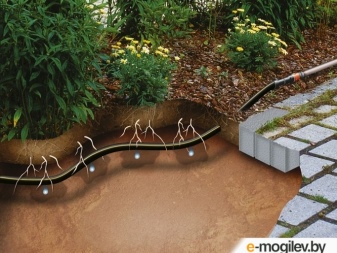
Underground installation of irrigation systems is suitable for areas in which there is a lack of moisture. In this case, its local supply is the best solution. The installation of a filter at the inlet to the pipeline helps to minimize the risks of clogging the holes.
Such irrigation systems are placed vertically, with output to the surface. The liquid is supplied to the roots of single plantings through a hose or watering can. At the same time, moisture is distributed more evenly, it goes directly to the destination. The irrigation rate can be varied taking into account the characteristics of the climatic zone.
With a large number of plantings of the same type (vineyard, etc.), you can connect the branches to the automated highway by connecting them together.

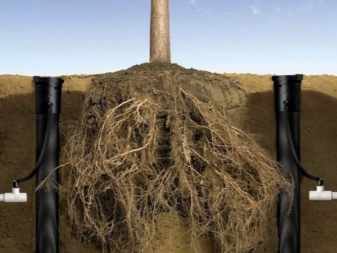
Rain
Irrigation systems of this type involve the supply of moisture to the area around the plant. It is carried out at a certain angle, similar to natural precipitation. Spraying functions are performed by special installations - sprinklers and sprinklers located above the ground or extending from it during the period of water supply. They are installed according to a certain scheme: taking into account the range of liquid spraying, the area of the site. The equipment is well suited for the care of lawns, flower beds, lawns.
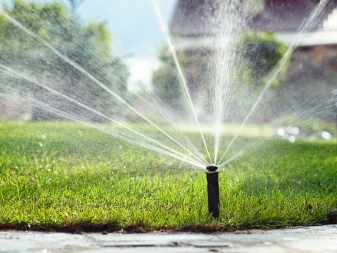

The advantages of sprinkler systems include the following characteristics:
- gradual moistening of the soil;
- the ability to regulate the frequency of watering;
- no harm to the structure of the soil;
- water supply not only to the roots, but also to the leaves;
- removal of dust and harmful insects.
Irrigation equipment of this type can be customized according to individual parameters. When calculating, factors such as the intensity of spraying moisture, as well as the ability of the soil to absorb it, must be taken into account. The liquid should not stagnate on the surface.
Such systems also have disadvantages. Sprayers lose spray uniformity in gusty winds, water pressure drops in the line.
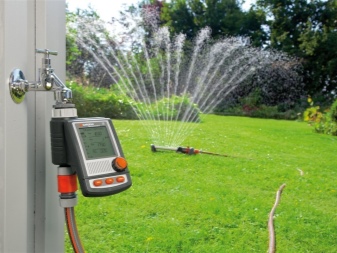
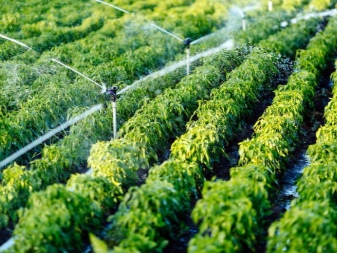
Drip
One of the most popular irrigation systems in arid regions is drip irrigation. They ensure the minimization of water consumption, make it possible to make its supply local (without waterlogging the roots). Moisture is supplied to the plants in small portions through a special tape connected to the central highway. It is optimal if the drip irrigation system includes a controller and automated elements that provide switching on by the hour. For round-the-clock irrigation in the absence of electricity, gravity options are used, in which the storage tank is located at a height above the ground.
Drip belts are easy to clog and need to be cleaned periodically. The rest of the system is as easy to use as possible. Tubular elements are easily placed on the beds, in greenhouses, and allow the saturation of moisture in the root zone without spraying it onto leaves and flowers. The droppers are placed locally, connected to a common line.
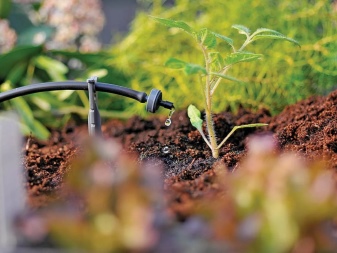
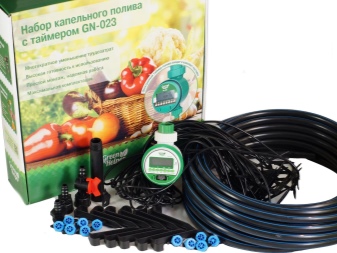
Design
Accurate calculation of all components for arranging irrigation systems allows you to avoid mistakes in the preparation and procurement of materials. To begin with, a drawing is created that includes:
- the layout of pipelines;
- points of their connection and interweaving;
- areas of location of valves.
Based on the location of the elements, the total length of the track is calculated. It is better to draw a drawing with reference to the site plan, with division into separate zones.
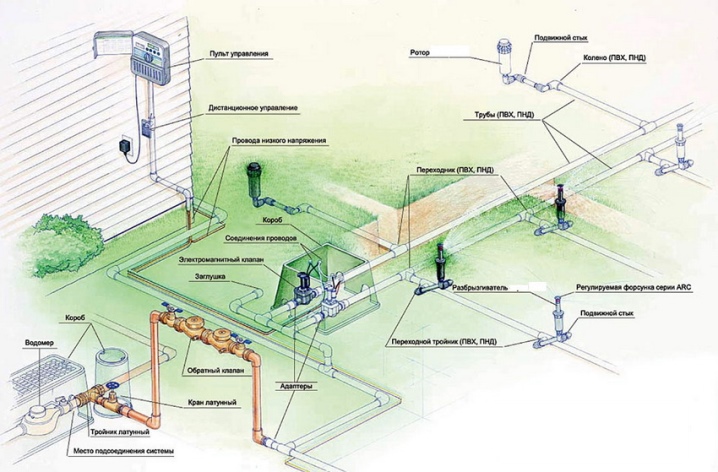
When placing individual elements of irrigation systems, you have to take into account their features. For example, sprinklers are installed at a distance of their radius of action from each other, in the opposite direction - this way the formation of "blind" zones is excluded.
The daily irrigation rate is also taken into account. For each type of plant, it has its own. For example, for a lawn you need from 5 to 10 l / m2, depending on the climatic zone and ambient temperature. This indicator is multiplied by the area of the site that needs moisture. The data obtained will correlate with the performance of the equipment, the duration of its operation.
Also, at the design stage, pipe diameters are calculated. The most commonly used option is 32 mm for two-zone irrigation or 25 mm for four-zone irrigation.

Mounting
Ready-made irrigation systems, complete with all the necessary equipment, can be easily installed in the country with your own hands. All that is needed for this is assembly and connection of the highway to a water supply source. In this capacity, not only wells or wells act quite successfully, but also reservoirs located at a sufficient height.
For pipes, it is best to opt for plastic options that do not react with fertilizers and pesticides. Surface must be made of opaque material, underground - withstand significant loads.
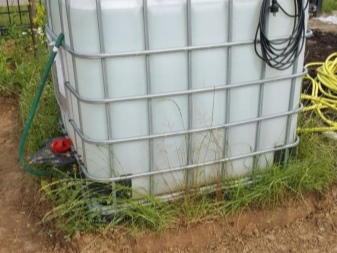
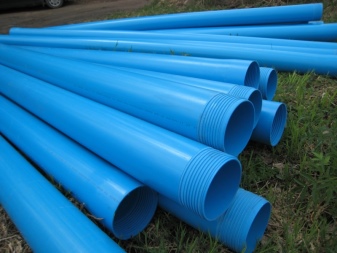
Let us consider step by step the installation of the simplest system with deepening.
- Excavation works. In accordance with the communications plan, a shovel bayonet-wide trench is dug. Its depth is selected in the range from 30 to 70 cm, it is imperative to form a small natural slope to the bottom point of the site. This will make it easier to drain the water at the end of the season.
- Preparation of pipes and fittings. It is optimal to take not metal, but plastic. The pipes are laid in a trench, with a cross or tee connected to the main line, control valves are mounted - separate for each section. Bends can be made with droppers or under sprinklers, here the diameter of the line can be reduced to 25-32 mm.
- System assembly. It is necessary to connect it, isolate the mounting sections with seals. Then the taps are connected to the line, if necessary, automatic equipment is installed.
- Trial. Water is started up into the irrigation system. At the same time, its tightness is monitored, the operability of all units and elements is checked. The identified problems are eliminated.
- Completion of work. The trench is filled with earth. If subsequent dismantling is planned, you can simply install trays or gratings over the pipes, as for storm sewers. In this version, it will be much easier to maintain the irrigation equipment.

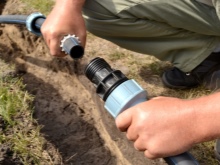
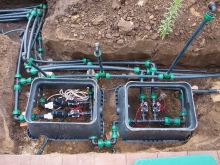
With this method of deepening the irrigation system, any type of spray can be connected. It is an economical and convenient solution that does not require complex maintenance.
Subsoil system
The construction of subsurface irrigation systems is carried out at the stage of planting a plant. A wider and deeper planting hole is dug to accommodate the equipment. On average, its dimensions increase in each direction by 25-30 cm.
Then you need to perform 4 steps.
- Backfilling the bottom with a layer of rubble. A "pillow" of 200 mm is enough.
- Placement of the pipe. It is located vertically, sinking 7-10 cm into the layer of rubble. The segment should protrude 100-120 mm above the soil surface.
- Backfilling of soil. A layer of about 10 cm is enough.
- Installing the plug. It is put on the edge of the pipe sticking out of the soil.
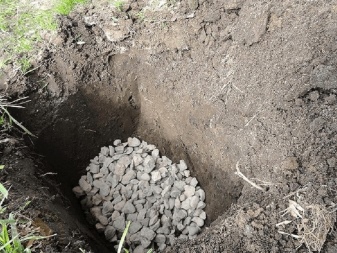
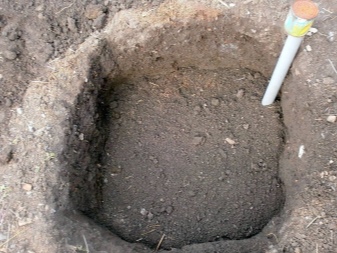
The ready-made system is used for local moisture supply or is mounted into a single network connected to the tank and pumping equipment.
Sprinklers
This type of equipment can be installed permanently or remain mobile. The first option involves surface or buried pipe laying with the formation of vertical bends at the nozzle installation sites. Sprinklers are put on these elements, when water is supplied, they ensure its spraying.
Portable irrigation is mounted using flexible hoses. It is better to choose products based on PVC or thermoplastic elastomer. Sprayers are installed at the ends of such pipes, and the line itself is connected to the reservoir and controller for automatic water supply. The system is easily and quickly deployed; it does not need to be preserved for the winter.
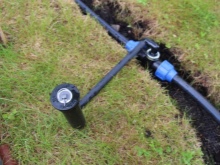
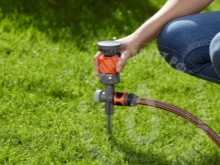
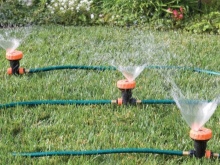
Care and maintenance
Irrigation equipment located on the site requires attention from the owner. At the end of the garden season, during the dormant period, when perennial plants do not need moisture, they are preserved. It consists in the complete removal of moisture from the pipeline. If there are drain or drain taps, it will be enough to simply open them.
If these elements are not provided in the system, the sequence of actions will be as follows:
- drainage of water from the storage tank - the taps are left open, otherwise in frost they will simply burst with pressure;
- disabling the system controller - you do not need to completely disconnect it, because most models easily tolerate wintering;
- draining water from the pump, removing the pump and sending it to storage in a warm place, a special plug at the bottom of the case will help drain the moisture;
- purging of pipes, it is performed by an air compressor.
Having prepared the irrigation system for winter, you can refuse to dismantle it, ensuring easy start-up of the irrigation unit in the spring.
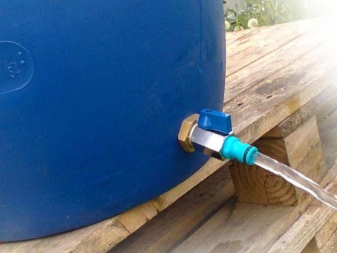
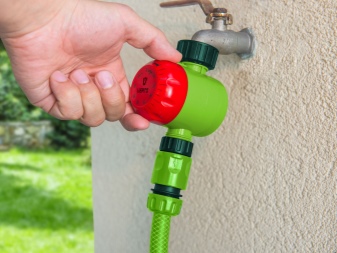
See below for installation of the irrigation system.













The comment was sent successfully.